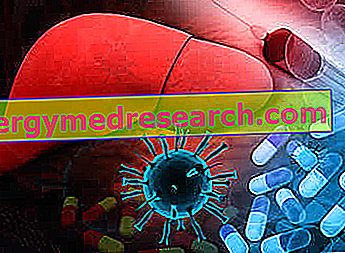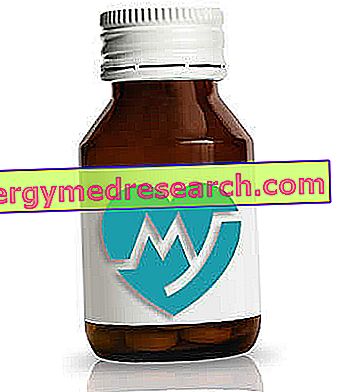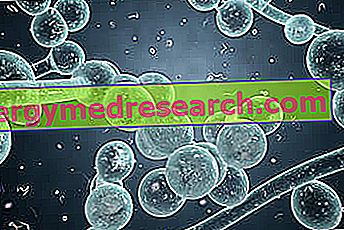Mononucleosis
Infectious mononucleosis is a contagious viral disease caused by the EBV virus.
About 90% of the population shows that they have already contracted the virus and has specific antibodies.

It is a self-limiting disease (3-4 weeks) which usually does not require any drug therapy.
Diagnosis is made on the basis of symptoms and clinical findings.
Role of the Diet
The role of diet in mononucleosis is that of support. Nutrition, in fact, is not a factor directly involved in healing from the infectious disease.
Mononucleosis is known to be extremely debilitating and, even after healing, does not allow the body to recover quickly. It must be remembered that a malnourished organism is NOT able to react effectively; on the contrary, a correct diet can reduce the overall recovery time.
In general, especially when mononucleosis begins with nausea, vomiting and fever, the diet must have the following characteristics:
- Small and frequent meals
- High digestibility
- Richness of water and potassium
- Richness of essential nutrients (especially omega 3 fatty acids) and phytoelements (phenolic antioxidants etc.)
- Probiotic food / supplements
- Nutrients that can support the immune system.
Small and frequent meals
The greater fragmentation of the diet is an essential characteristic to avoid overloading the digestive system.
This goal can be achieved by adding some snacks or emphasizing the nutritional importance of secondary meals. For example:
| NORMAL DISTRIBUTION | I) DISTRIBUTION OF MONONUCLEOUS DIETS | II) DISTRIBUTION OF MONONUCLEOUS DIET | |||
| Breakfast | 15% energy | Breakfast | 15% energy | Breakfast | 15% energy |
| Snack I | 5% energy | Snack I | 10% energy | Snack I | 5% energy |
| / | / | Snack II | 5% energy | ||
| Lunch | 40% energy | Lunch | 30% energy | Lunch | 30% energy |
| Snack II | 5% energy | Snack II | 10% energy | Snack III | 5% energy |
| / | / | Snack VI | 5% energy | ||
| Dinner | 35% energy | Dinner | 25% energy | Dinner | 25% energy |
| / | Snack III | 10% energy | Snack III | 10% energy | |
In practice, to break up meals, it is sufficient to move the foods that normally make up breakfast, lunch and dinner, in the various snacks of the day. For example:
| NORMAL DISTRIBUTION | I) DISTRIBUTION OF MONONUCLEOUS DIETS | II) DISTRIBUTION OF MONONUCLEOUS DIET |
| Breakfast: Milk, Cereals, Bread and Jam, Apple | Breakfast: Bread and Jam, Apple and Yogurt | Breakfast: Bread and Jam |
| Snack I: Yogurt | Snack I: Bread and Jam | Snack I: Milk and Cereals |
| / | / | Snack II: Apple and Yogurt |
digestibility
Digestibility must concern:
- All meals
- The recipes that compose them
- The individual ingredients.
Food characteristics:
- Reduced portions (see above)
- Few fats, especially saturated ones; cheeses are not suitable, while lean fish or fat seeds (anchovies, sardines, cod etc.) and lean white meat (chicken breast, rabbit, etc.) are suitable
- Free of indigestible parts (eg the skins of certain vegetables and legumes, the connective tissues of meat, etc.)
- 30g of total fiber. Better not to overdo it or the risk would be to compromise digestion
- Condiments limited to 1-2 teaspoons of extra virgin olive oil each dish; this product, if used sparingly, is able to improve the digestibility of meat and fish.
NB . Overall, 25-30% of total calories in the form of lipids should not be exceeded.
- Complete cooking of protein foods (meat, fish products and eggs), or up to the heart of the food. Absolutely avoid: cooking with blood (rib eye and grilled fillet), carpaccio or tartare, and cooking too long (stews, omelettes, soups, etc.).
- The most suitable cooking systems are: boiling, steaming, pressing, bain-marie, vacuum-packed and potted.
Plenty of Water
Respecting the principle of digestibility and assuming that the impulse of vomiting concedes it, the most used foods should be rich in water and potassium. This is because, in case of diarrhea, faecal losses increase dramatically.
Foods rich in water include: milk and yogurt (in the absence of food intolerance), fresh fruit, fresh vegetables, pasta in broth, legumes in broth, pureed, velvety, smoothies and centrifuges.
In addition to maintaining the state of hydration, fruit and vegetables contribute to providing a lot of potassium and antioxidants useful for strengthening the immune system (both vitamins and phenolics).
Richness of Omega 3
Omega 3s are anti-inflammatory molecules. Besides being potentially deficient in the customary diet, it is possible that mononucleosis increases metabolic demand. This is why the specific diet must contain: blue fish (sardines, bonito, mackerel, etc.) and some oil seeds (for example those of flax) or their oils; if you like, edible algae are also an excellent source.
Probiotics
The probiotics in the diet for mononucleosis are useful in case of diarrhea, thanks to their ability to:
- Keep the intestine healthy by producing nutrients such as short-chain fatty acids and specific polyamines
- Intervene positively on the trophism of the immune system
- Produce vitamins.
Support the Immune System
To support the action of the immune system, the diet for mononucleosis must contain foods rich in antioxidants.
These molecules, of vitaminic origin (vitamin A, vitamin C and vitamin E), saline (zinc and selenium) and phenolic (but not only), are necessary for cellular protection from oxidative stress.
Furthermore, vitamins C and D seem to play a fundamental role in the infectious response to viruses (see also: Cold Diet).
The sources of these nutrients are:
- Phenols, in all their variants; they abound above all in vegetables, fruit and legumes. It is such a wide category that it is impossible to summarize the main sources for each of them (berries, grapes, blueberries, other fruits, tea, propolis, etc.)
- Carotenoids (provitamine A) abound in: carrots, melon, tomato etc.
- Vitamin C is present above all: in chilli, in parsley, in citrus fruits, in kiwi, in apples, in lettuce, etc.
- Vitamin E is very abundant in oils and oilseeds
- Zinc and selenium abound in oilseeds and meat (with the due differences between the two, depending on the product)
- Vitamin D is predominantly endogenous; it is produced in the skin starting from cholesterol by exposure to UV rays. However, fishery products and eggs are excellent sources of this vitamin.



